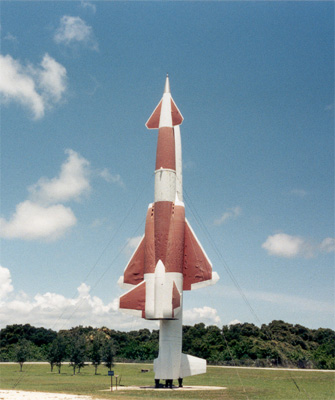
| North American Navaho missile (circa 1996) |
| Navaho specifications and performance | |||
| Length | Missile: 67 ft. 9 in. Booster: 76 ft. 3 in. |
Wingspan | 28 ft. 7 in. |
| Thrust | Missile: 2 x 15,000 lb. Booster: 2 x 240,000 lb. |
Speed | Mach 2.75 |
| Ceiling | 80,000 ft. | Range | 3500 miles |
The "Navaho Missile" was in reality a pilotless aircraft consisting of two components: a missile and a booster. The G-26 missile (the orange and white winged craft) contained the guidance equipment, two ramjets for propulsion, and landing gear. The missile rode "piggyback" on the G-26 booster (the white unit in the picture). The booster contained two rocket engines powered by LOX (Liquid Oxygen) and alcohol. After propelling the missile to altitude (43,000 feet) at a speed of nearly Mach 3, the booster was jettisoned. The missile would continue its flight alone, then land.
The Navaho missile shown in the picture was at the Air Force Space & Missile Museum. This missile is the only Navaho in existence, being the only surviving missile of the six that remained when the project was cancelled. It has since been refurbished and moved to Gate 1.
The Navaho program began in 1946. Its goal was to determine the feasibility of an intercontinental missile. Though the Navaho program is little known, it produced many "firsts" in aviation: the first jet aircraft to reach speeds of Mach 3, the first to use inertial guidance, the first to fly above 77,000 feet. The Navaho program was cancelled in 1957, after repeated delays in testing. The major reason for the cancellation of the Navaho program was the successful development of the Atlas ICBM (which made the Navaho obsolete from a military standpoint).